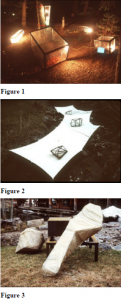Michael Whiting and Professor Brian Christensen, Visual Arts
This creative grant resulted in three sites of sculpture that were displayed at Sundance resort, April 1 through April 30, 1999. These three sites were intended to create a dialogue between the man made objects themselves and their surroundings. The project explored the ability to transform the meaning of a specific site, through the manipulation of sculptural space, at the same time exploring the relationship between man and nature.
Reliquaries (fig1) explores the idea of self-contained environments within natural spaces as it relates to man and the world we have created for ourselves. Technology is an integral part of our society. We rely on it for communication, food, health, entertainment, and transportation. Almost every aspect of our daily lives is dependent upon a form of technology. Even within the realm of “nature” man’s use of technology is prevalent. When we go to the mountains for escape, we bring our space age fabric clothes and shelters, we bring cell phones for communication, and we arrive in our cars. We think nothing of finding bridges and restrooms in the most remote locations. Technology has in many ways improved our way of life. Our life spans are longer, and life is comfortable. We have more free time and are allowed many more experiences. We are also subject to technology for our lives. We cannot separate “us” from technology. These installations of sculpture portray this influence of man on nature as well as the nature’s influence on man. This juxtaposition is created through the use of icons and man-made materials placed in natural spaces. The Plexiglas boxes exist within natural surroundings, while an environment consisting of technological devices, (i.e.; television monitors and shop lights) exists within the boxes. These new objects transform the meaning of the site. The viewer is forced to make sense of these objects in their seemingly contrasting surroundings. In retrospect, I would like to have routed video cameras to the monitors, so that the outside surroundings would have been displayed on the monitors. I feel this would have completed the link between the idea of self-contained environments and the outdoor setting.
Nesting Structures (fig2) follows most closely my proposed project. It is specific to the bend in the river. The canvas was cut to match that specific bend. Much like Reliquaries, it is a comment on man’s acceptance of superimposed structures on a natural landscape. Nesting Structures is similar to power lines, telephone poles, or bridges. The piece is unexpected. It is not what one expects to see in a river. It seems to be out of place, but there is no other place that it would belong and so we just accept it. The structures evolved from line drawings of closed forms. They are composed of a network of steel bars welded together. The canvas acts as an intermediary between the structures and the river. The canvas filters water where the structures are placed, and as the steel rusts, the canvas begins to discolor. There is again the contrast of permanence and impermanence. The interplay of the land, water, and materials creates an ever-changing piece. Water cycles and the materials deteriorate.
Begin (fig3), unlike the others, is not dependent on any specific environment, but rather creates its own spaces. Begin consists of two steel structures covered in resin and muslin, similar to those in Nesting Structures. The covered structures rest on a fabricated steel table and the table- like section creates a plane on which the wrapped frames exist. This sculpture does not interact with its surroundings as successfully as the other sites, yet the parts interact with each other creating a dialogue between the forms themselves.
These installations redefine the spaces they occupy. They make us reassess our role with nature. The relationship of man to nature is something we are faced with every day. We transform our world to better suit our lifestyles while at the same time we are forced to adapt to nature. Through this project I had hoped to provide a meaningful experience that would help people reflect on our situation.

